Experimental Investigation of Detonation Propagation Modes and Thrust Performance in a Small Rotating Detonation Engine Using C2H4/O2 Propellant
Abstract
1. Introduction
| PDE (or PDC) | RDE (or RDC) | |
|---|---|---|
| Combustor Type | Cylindrical | Circular |
| Initiation Event | Periodic | Single |
| Propagation Mode | Periodic | Continuous (self-sustained detonation) |
| Operation Frequency | 0.01–1.0 kHz [11,12] (depending on length and response time of supply system) | 1.0–100.0 kHz [13] (depending on circumferential length and the number of detonation waves) |
| Detonation Speed | Close to CJ detonation speed | Lower than CJ speed |
| Application | Propulsion, Thermal spray, Reaction control system, Combustion wave igniter | Propulsion, Combustor |
2. Experimental Methods
2.1. Detonation Cell Width and Initiation Energy
2.2. RDE Model Configuration
2.3. Experimental Procedure
2.4. Mass Flow Rate
3. Detonation Wave Propagation Characteristics in RDE
3.1. RDE Initiation Characteristics
3.2. Regular Operation Characteristics
3.3. Detonation Wave Speed in RDE
4. RDE Performance
5. Conclusions
- Immediately after the detonation initiation, an irregular flow was temporarily formed that repeats a series of processes of initiation, propagation, decaying and merging of detonation waves, though periodically unsteady flow should be formed in the combustion channel for the stable operation of RDE.
- Under the experimental conditions, the number of detonation waves rotating along the outer wall of the combustion channel was predominantly two. Three stable detonation waves were temporarily captured at the mass flow rate of 131.4 g/s.
- The number of detonation waves is within the predicted range by comparing the number of detonation waves obtained by the prediction equation. The empirical prediction equation is considered a useful tool for predicting the number of waves in the RDE.
- The detonation speed rotating along the outer wall of the combustion channel is always lower than the CJ detonation speed. The velocity deficit is considered to be the result of lower heat addition rather than the ideal case, which is caused by incomplete combustion, itself caused by poor mixing, which occurs because the two-dimensional injector is not the optimized configuration. In addition, the open-type unchoked combustor channel and the inclination of detonation wave are considered an additional source of velocity deficit.
- The thrust and specific impulse were slightly increased by applying an expansion nozzle of 30.0°. The characteristic velocity efficiency shows low values as the static pressure in the combustion channel stays low.
Author Contributions
Funding
Institutional Review Board Statement
Informed Consent Statement
Data Availability Statement
Acknowledgments
Conflicts of Interest
Nomenclature
| throat area | |
| Chapman–Jouguet | |
| characteristic velocity | |
| inner diameter of combustion channel | |
| outer diameter of combustion channel | |
| thrust | |
| F.S. | full scale |
| gravity | |
| height of combustion mixture layer | |
| specific impulse | |
| optimal length of combustion channel | |
| total mass flow rate | |
| detonation wave number | |
| stagnation pressure | |
| gas constant | |
| time | |
| temperature | |
| detonation speed | |
| equivalence ratio | |
| characteristic velocity efficiency | |
| specific heat ratio | |
| detonation cell width | |
| width of combustion channel | |
| specific volume for mixture | |
| Subscripts | |
| combustion channel | |
| ideal | |
| measured | |
| maximum | |
| minimum |
References
- Barr, L. Pulsed Detonation Engine Flies into History. Press Release, Air Force Material Command. Available online: https://www.af.mil/News/Article-Display/Article/123534/pulsed-detonation-engine-flies-into-history/ (accessed on 16 May 2008).
- Kasahara, J.; Hasegawa, A.; Nemoto, T.; Yamaguchi, H.; Yajima, T.; Kjima, T. Performance Validation of a Single-Tube Pulse Detonation Rocket System. J. Propuls. Power 2009, 25, 173–180. [Google Scholar] [CrossRef]
- Matsuoka, K.; Morozumi, T.; Takagi, S.; Kasahara, J.; Matsuo, A.; Funaki, I. Flight Validation of a Rotary-Valved Four-Cylinder Pulse Detonation Rocket. J. Propuls. Power 2016, 32, 1–9. [Google Scholar] [CrossRef]
- Rasheed, A.; Furman, A.H.; Dean, A.J. Experimental Investigations of the Performance of a Multitube Pulse Detonation Turbine System. J. Propuls. Power 2011, 27, 586–596. [Google Scholar] [CrossRef]
- Endo, T.; Obayashi, R.; Tajiri, T.; Kimura, K.; Morohashi, Y.; Johzaki, T.; Matsuoka, K.; Hanafusa, T.; Mizunari, S. Thermal Spray Using a High-Frequency Pulse Detonation Combustor Operated in the Liquid-Purge Mode. J. Therm. Spray Technol. 2016, 25, 494–508. [Google Scholar] [CrossRef]
- Matsuoka, K.; Muto, K.; Kasahara, J.; Watanabe, H.; Matsuo, A.; Endo, T. Investigation of Fluid Motion in Valveless Pulse Detonation Combustor with High-Frequency Operation. Proc. Combust. Inst. 2017, 36, 2641–2647. [Google Scholar] [CrossRef]
- Kasahara, J.; Kawasaki, A.; Matsuoka, K.; Matsuo, A.; Funaki, I.; Nakata, D.; Uchiumi, M. Research and Development of Rotating Detonation Engine System for the Sounding Rocket Flight Experiment S520–31. In AIP Conference Proceedings; AIP Publishing LLC: Melville, NY, USA, 2019; Volume 2021, p. 020001. [Google Scholar] [CrossRef]
- Han, H.S.; Kim, J.M.; Oh, S.J.; Choi, J.Y. An Experimental Study on Characteristics of Small-scale PDE under Low-frequency Operating Conditions. J. Korean Soc. Propuls. Eng. 2018, 22, 81–89. [Google Scholar] [CrossRef]
- Cuppoletti, D.; Ombrello, T.; Carter, C.; Hammack, S.; Lefkowitz, J. Ignition Dynamics of a Pulse Detonation Igniter in a Supersonic Cavity Flameholder. Combust. Flame 2020, 215, 376–388. [Google Scholar] [CrossRef]
- Roy, G.D.; Frolov, S.M.; Borisov, A.A.; Netzer, D.W. Pulse Detonation Propulsion: Challenges, Current Status, and Future Perspective. Prog. Energy Combust. Sci. 2004, 30, 545–672. [Google Scholar] [CrossRef]
- Matsuoka, K.; Taki, H.; Kawasaki, A.; Kasahara, J.; Watanabe, H.; Matsuo, A.; Endo, T. Semi-valveless Pulse Detonation Cycle at a Kilohertz-scale Operating Frequency. Combust. Flame 2019, 205, 434–440. [Google Scholar] [CrossRef]
- Matsuoka, K.; Taki, H.; Kasahara, J.; Watanabe, H.; Matsuo, A.; Endo, T. Pulse Detonation Cycle at Kilohertz Frequency. Detonation Control for Propulsion: Pulse Detonation and Rotating Detonation Engine, 1st ed.; Li, J.M., Teo, C.J., Khoo, B.C., Wang, J.P., Wang, C., Eds.; Springer: Cham, Switzerland, 2018; pp. 183–198. [Google Scholar]
- Matsuoka, K.; Yamaguchi, M.; Kawasaki, A.; Kasahara, J.; Watanabe, H.; Matsuo, A. Reflective Shuttling Detonation Cycle in a Fan-Shaped Two-Dimensional Combustor. In Proceedings of the International Workshop on Detonation for Propulsion 2018, Xi’an, China, 9–12 September 2018. [Google Scholar]
- Cullen, R.E.; Nicholls, J.A.; Ragland, K.W. Feasibility Studies of a Rotating Detonation Wave Rocket Motor. J. Spacecr. Rocket. 1966, 3, 893–898. [Google Scholar]
- Bykovskii, F.A.; Zhdan, S.A.; Vedernikov, E.F. Continuous Spin Detonations. J. Propuls. Power 2006, 22, 1204–1216. [Google Scholar] [CrossRef]
- Hansmetzger, S.; Zitoun, R.; Vidal, P. Detonation Regimes in a Small-scale RDE. In Proceedings of the 26th International Colloquium on the Dynamics of Explosions and Reactive Systems, Boston, MA, USA, 30 July–4 August 2017. [Google Scholar]
- Kato, Y.; Ishihara, K.; Matsuoka, K.; Kasahara, J.; Matsuo, A.; Funaki, I. Study of Combustion Chamber Characteristic Length in Rotating Detonation Engine with Convergent–Divergent Nozzle. In Proceedings of the 54th AIAA Aerospace Sciences Meeting, San Diego, CA, USA, 4–8 January 2016. AIAA 2016–1406. [Google Scholar]
- Rankin, B.A.; Fotia, M.L.; Paxson, D.E.; Hoke, J.L.; Schauer, F.R. Experimental and Numerical Evaluation of Pressure Gain Combustion in a Rotating Detonation Engine. In Proceedings of the 53rd AIAA Aerospace Sciences Meeting, Kissimmee, FL, USA, 5–9 January 2015. AIAA 2015–0877. [Google Scholar]
- Wilhite, J.; Driscoll, R.; George, A.S.; Anand, V.; Gutmark, E.J. Investigation of a Rotating Detonation Engine using Ethylene–Air Mixtures. In Proceedings of the 54th AIAA Aerospace Sciences Meeting, San Diego, CA, USA, 4–8 January 2016. AIAA 2016–1650. [Google Scholar]
- Peng, L.; Wang, D.; Wu, X.; Ma, H.; Yang, C. Ignition Experiment with Automotive Spark on Rotating Detonation Engine. Int. J. Hydrogen Energy 2015, 40, 8465–8474. [Google Scholar] [CrossRef]
- Kindracki, J.; Wolanski, P.; Gut, Z. Experimental Research on the Rotating Detonation in Gaseous Fuels–Oxygen Mixtures. Shock Waves 2011, 21, 75–84. [Google Scholar] [CrossRef]
- George, A.S.; Randall, S.; Anand, V.; Driscoll, R.; Gutmark, E. Characterization of Initiator Dynamics in a Rotating Detonation Combustor. Exp. Therm. Fluid Sci. 2016, 72, 171–181. [Google Scholar] [CrossRef]
- Anand, V.; St. George, A.; Driscoll, R.; Gutmark, E. Experimental Investigation of H2–Air Mixtures in a Rotating Detonation Combustor. In Proceedings of the ASME Turbo Expo 2015: Turbine Technical Conference and Exposition, Montreal, QC, Canada, 15–19 June 2015. [Google Scholar]
- Bykovskii, F.A.; Vasil’ev, A.A.; Vedernikov, E.F.; Mitrofanov, V.V. Explosive Combustion of a Gas Mixture in Radial Annular Chambers. Combust. Explos. Shock Waves 1994, 30, 510–516. [Google Scholar] [CrossRef]
- Fotia, M.L.; Schauer, S.D.; Kaemming, T.; Hoke, J.L. Experimental Study of the Performance of a Rotating Detonation Engine with Nozzle. J. Propuls. Power 2016, 32, 674–681. [Google Scholar] [CrossRef]
- Boening, J.A.; Wheeler, E.A.; Heath, J.D.; Koch, J.V.; Mattick, A.T.; Breidenthal, R.E.; Knowlen, C.; Kurosaka, M. Rotating Detonation Engine Using a Wave Generator and Controlled Mixing. J. Propuls. Power 2018, 34, 1–12. [Google Scholar] [CrossRef]
- Lin, W.; Zhou, J.; Liu, S.; Zhuang, F. Experimental Study on Propagation Mode of H2/Air Continuously Rotating Detonation Wave. Int. J. Hydrogen Energy 2015, 40, 1980–1993. [Google Scholar] [CrossRef]
- Rankin, B.A.; Richardson, D.R.; Caswell, A.W.; Naples, A.G.; Hoke, J.L.; Schauer, F.R. Chemiluminescence Imaging of an Optically Accessible Non-Premixed Rotating Detonation Engine. Combust. Flame 2017, 176, 12–22. [Google Scholar] [CrossRef]
- Yi, T.H.; Lou, J.; Turangan, C.; Choi, J.Y.; Wolanski, P. Propulsive Performance of a Continuously Rotating Detonation Engine. J. Propuls. Power 2011, 27, 171–181. [Google Scholar] [CrossRef]
- Wolanski, P. Rotating Detonation Wave Stability. In Proceedings of the 23rd International Colloquium on the Dynamics of Explosions and Reactive Systems, Irvine, CA, USA, 24–29 July 2011. [Google Scholar]
- Nordeen, C.A.; Schwer, D.; Schauer, F.; Hoke, J.; Barber, T.; Cetegen, B. Thermodynamic Model of a Rotating Detonation Engine. Combust. Explos. Shock Waves 2014, 50, 568–577. [Google Scholar] [CrossRef]
- Schwer, D.; Kailasanath, K. Numerical Investigation of the Physics of Rotating–Detonation-engines. Proc. Combust. Inst. 2011, 33, 2195–2202. [Google Scholar] [CrossRef]
- Schauer, F.R.; Miser, C.L.; Tucker, K.C.; Bradley, R.P.; Hoke, J.L. Detonation Initiation of Hydrocarbon–Air Mixtures in a Pulsed Detonation Engine. In Proceedings of the 43rd AIAA Aerospace Sciences Meeting and Exhibit, Reno, NV, USA, 10–13 January 2005. AIAA 2005–1343. [Google Scholar]
- Matsui, H.; Lee, J.H.S. On the Measure of the Relative Detonation Hazards of Gaseous Fuel–Oxygen and Air Mixtures. Proc. Combust. Inst. 1979, 17, 1269–1280. [Google Scholar] [CrossRef]
- Gelfand, B.E.; Frolov, S.M.; Nettleton, M.A. Gaseous Detonations-A Selective Review. Prog. Energy Combust. Sci. 1991, 17, 327–371. [Google Scholar] [CrossRef]
- Thomas, G.O. Flame Acceleration and the Development of Detonation in Fuel–Oxygen Mixtures at Elevated Temperature and Pressures. J. Hazard. Mater. 2009, 163, 783–794. [Google Scholar] [CrossRef] [PubMed]
- Moen, I.O.; Donato, M.; Knystautas, R.; Lee, J.H.S. The Influence of Confinement on the Propagation of Detonations near the Detonability Limits. Proc. Combust. Inst. 1981, 18, 1615–1622. [Google Scholar] [CrossRef]
- Bradley, C.M. A Kinetic Approach to Detonation in Gaseous Hydrogen– and Hydrocarbon–Oxygen Systems. Ph. D. Dissertation, University of London, London, UK, 1997. [Google Scholar]
- Wu, M.H.; Burke, M.P.; Son, S.F.; Yetter, R.A. Flame Acceleration and the Transition to Detonation of Stoichiometric Ethylene/Oxygen in Microscale Tubes. Proc. Combust. Inst. 2007, 31, 2429–2436. [Google Scholar] [CrossRef]
- Wu, M.H.; Kuo, W.C. Transmission of Near-Limit Detonation Wave through a Planar Sudden Expansion in a Narrow Channel. Combust. Flame 2012, 159, 3414–3422. [Google Scholar] [CrossRef]
- Makris, A.; Oh, T.J.; Lee, J.H.S.; Knystautas, R. Critical Diameter for the Transmission of a Detonation Wave into a Porous Medium. Proc. Combust. Inst. 1994, 25, 65–71. [Google Scholar] [CrossRef]
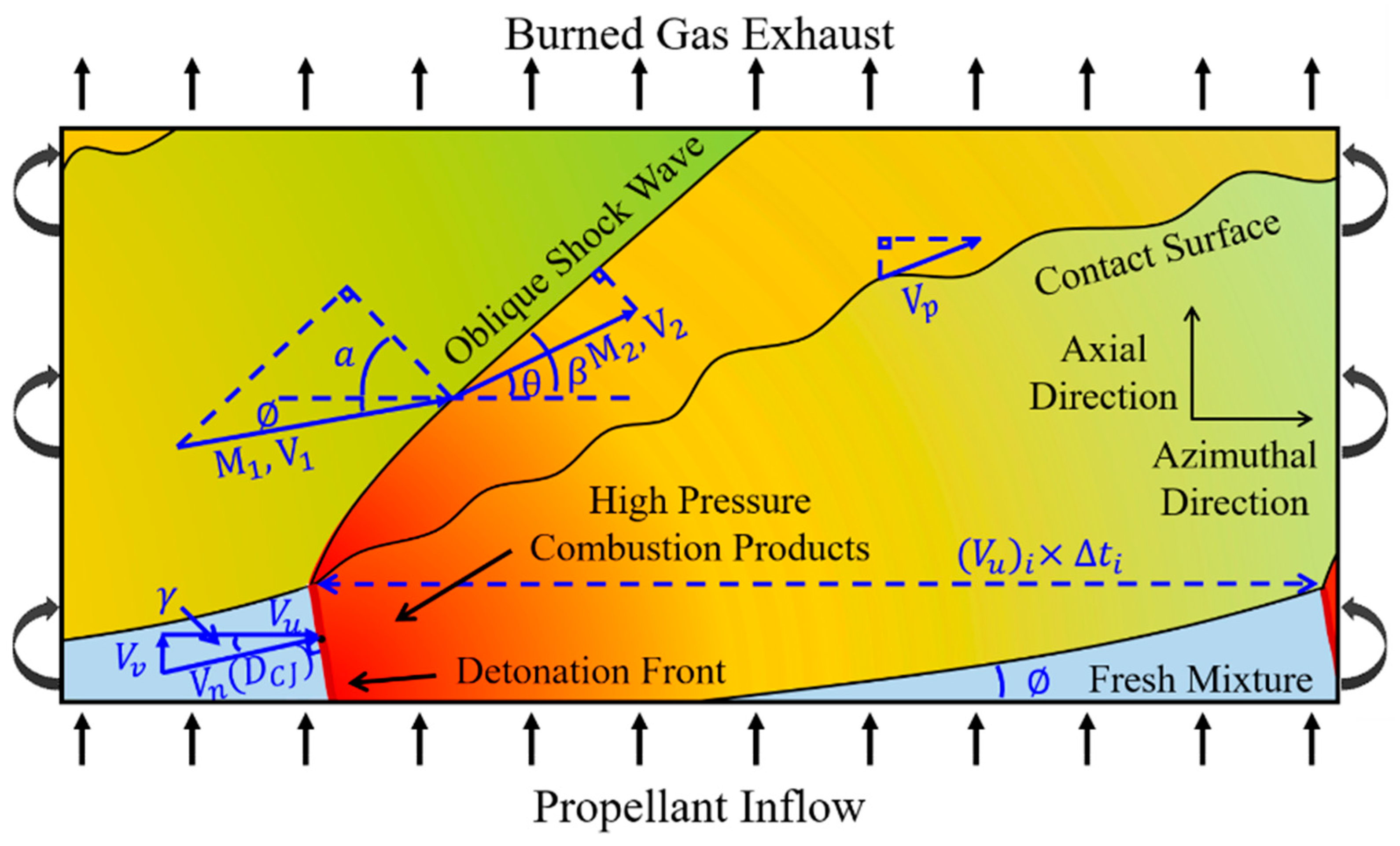

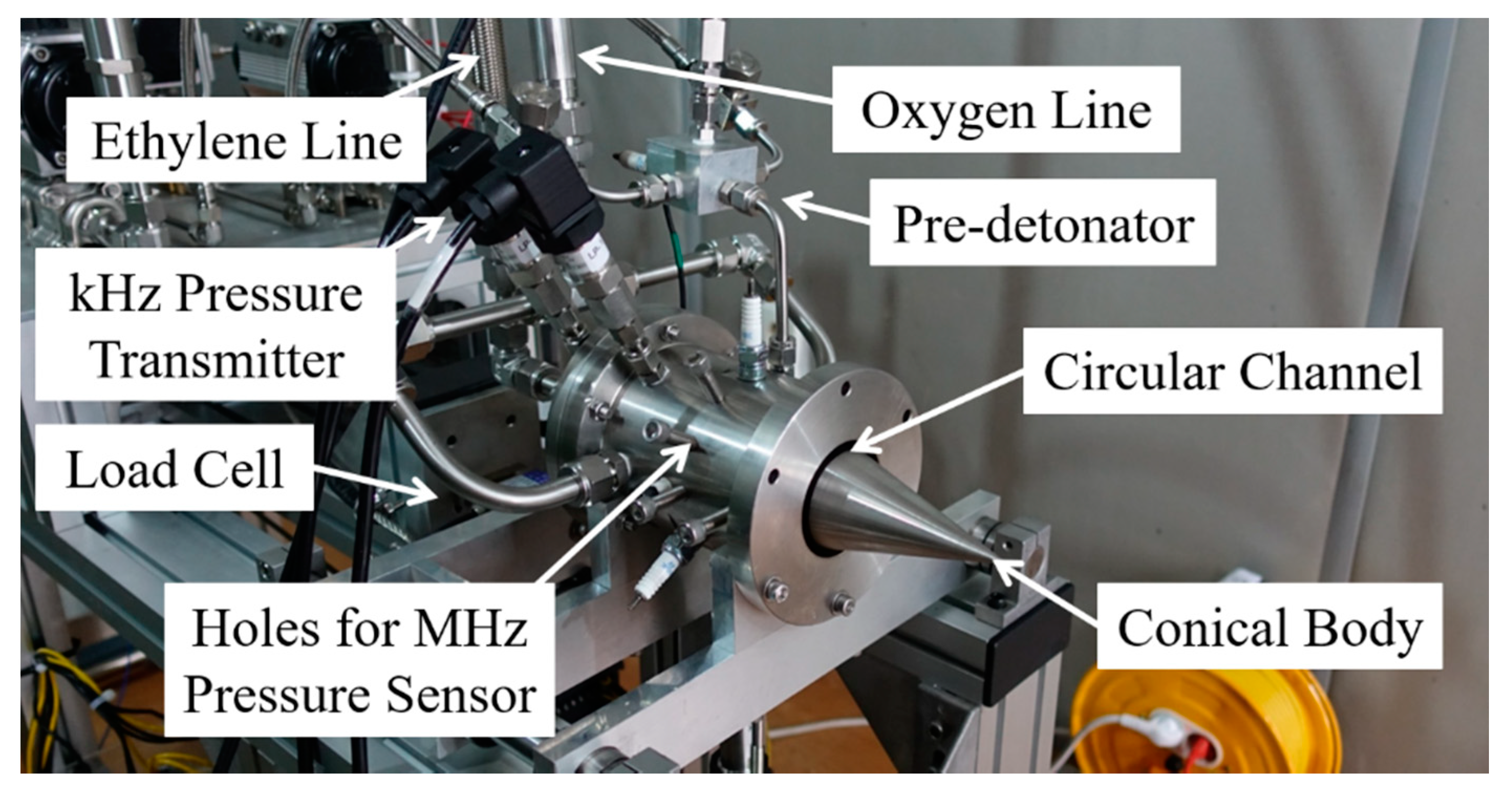
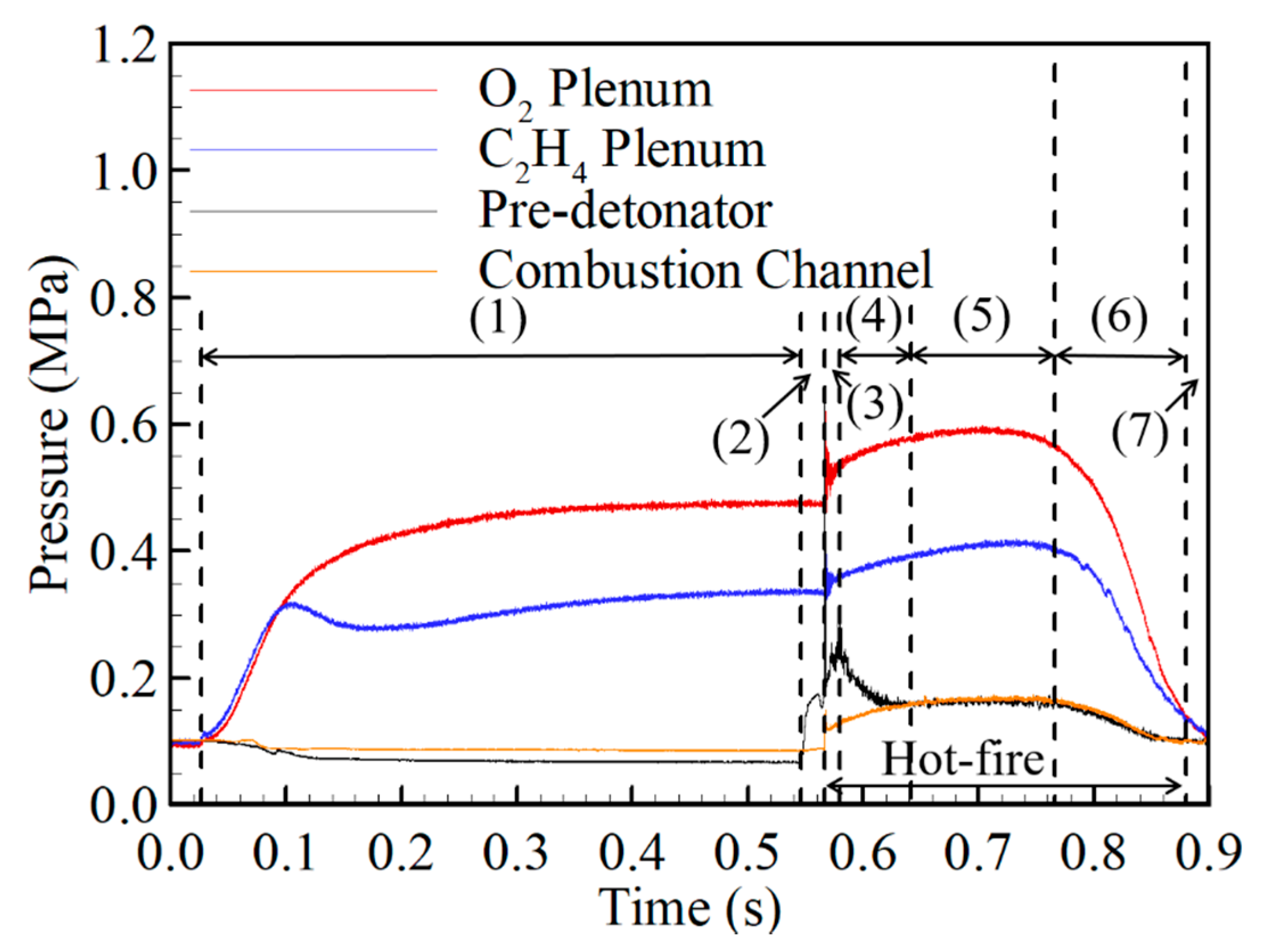


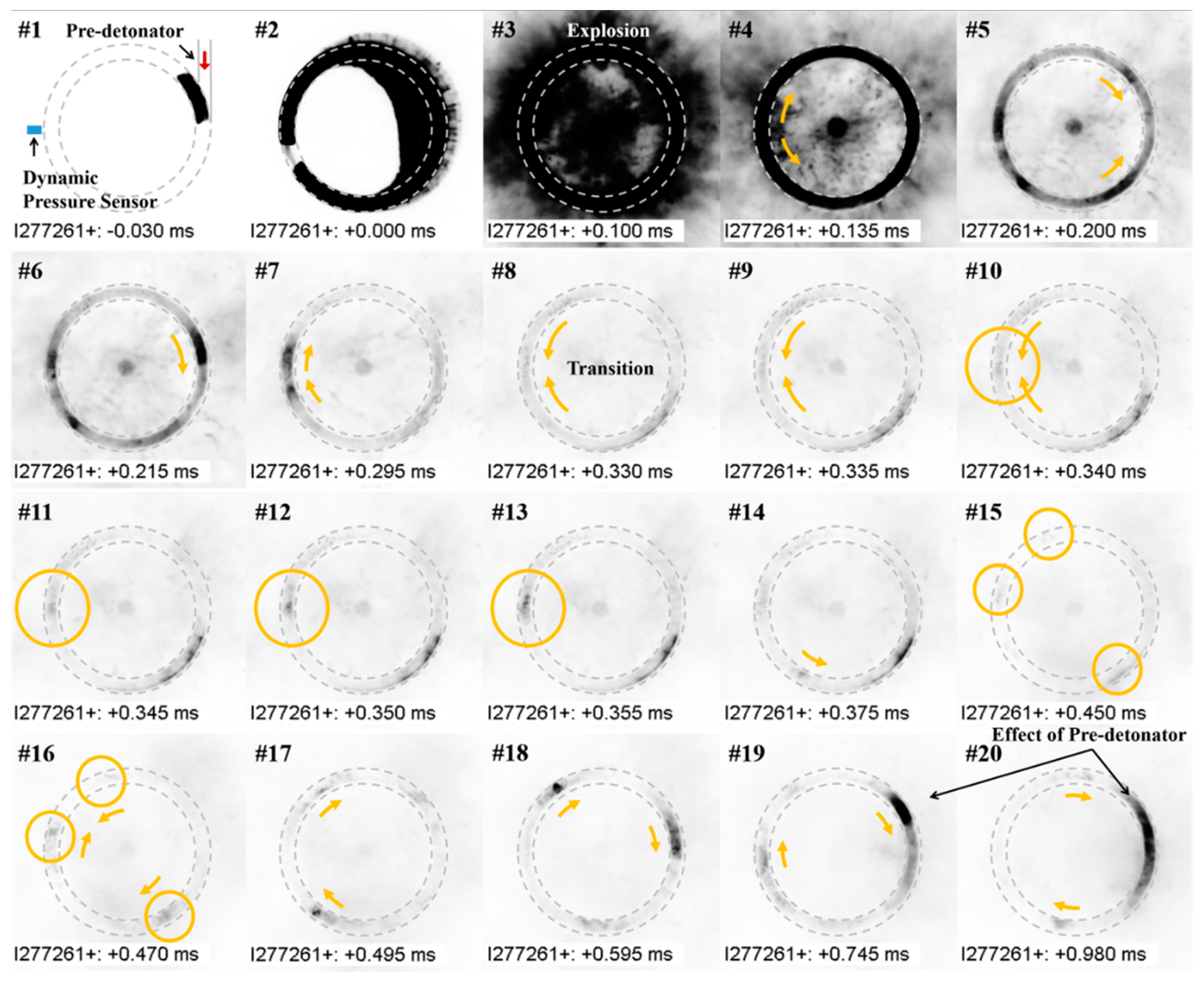




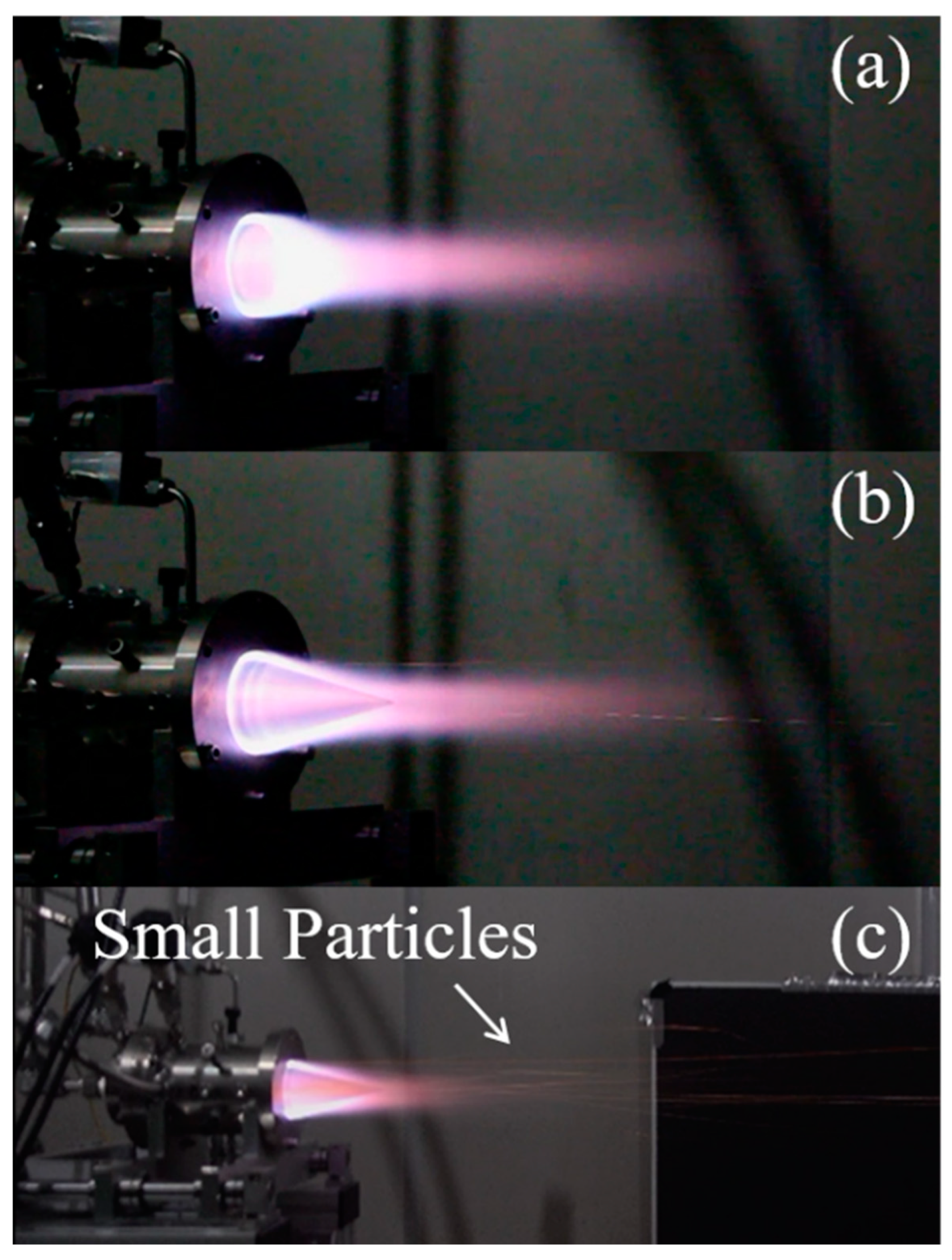


| Cell Width (mm) | Ref. | Note | |
|---|---|---|---|
| Schauer | 0.79 | [33] | - |
| Matsui | 0.57 | [34] | - |
| Gelfand | 0.57–0.60 | [35] | by Ref. [34] |
| Thomas | 0.80 | [36] | - |
| Moen | 0.57–0.72 | [37] | by Ref. [34] |
| Bradley | 0.65 | [38] | - |
| Wu | 0.52–0.80 | [39,40] | by Refs. [34,35,36] |
| Makris | 0.50 | [41] | - |
| Propellant | Injector | Combustion Channel | *** (g/s) | Ref. | ||||||
|---|---|---|---|---|---|---|---|---|---|---|
| Type | Size (mm) × (Number of Holes) | O.D. ** (mm) | Width (mm) | Length (mm) | ||||||
| Ox. * | Fuel | Ox. * | Fuel | |||||||
| Hansmetzger 2017 | C2H4/O2 | Slot | Slot | 0.5 | 0.3 | 70.0 | 10.0 | 90.0 | 120 | [16] |
| Kasahara 2016 | C2H4/O2 | Slot | Hole | 0.3, 1.0 | 0.5 × (72), 0.66 × (72) | 66.9 | 3.2 | 48.0 | 200 | [17] |
| Rankin 2015 | H2/Air | Slot | Hole | 0.89, 1.78, 3.56 | 0.71 × (80), 0.89 × (120) | 153.9 | 7.6 | 101.6 | 860 | [18] |
| Gutmark 2016 | C2H4/Air | Slot | Hole | 1.59 | (0.32 cm2) | 98.2 | 13.1 | 121.0 | 550 | [19] |
| Peng 2015 | H2/Air | Slot | Hole | 0.5 | 0.8 × (90) | 80.0 | 5.0 | 40.0 | 210 | [20] |
| Minimum Value (mm) | Maximum Value (mm) | |
|---|---|---|
| 11.1 | 48.7 | |
| 28.0 | 68.0 | |
| 1.4 | 3.4 |
| (g/s) | 54.3 | 64.4 | 107.0 | 131.4 | |
|---|---|---|---|---|---|
| = 0.5 | 0.9 | 0.9 | 1.5 | 1.8 | |
| 2.3 | 2.3 | 3.6 | 4.4 | ||
| = 0.8 | 0.6 | 0.6 | 0.9 | 1.1 | |
| 1.4 | 1.4 | 2.2 | 2.7 | ||
| Experiment | 2 | 2 | 2 | 2–3 | |
| Experiment | CJ Condition | ||||
| (A) | (B) | (C) | (D) | = 0.97–1.04 | |
| Frequency (Hz) | 13,940–14,880 | 16,670–16,980 | 17,180–18,500 | 17,080–18,850 | 25,454–25,821 (Two Waves) |
| Speed (m/s) | 1291–1378 | 1544–1573 | 1591–1714 | 1582–1746 | 2359–2393 |
Publisher’s Note: MDPI stays neutral with regard to jurisdictional claims in published maps and institutional affiliations. |
© 2021 by the authors. Licensee MDPI, Basel, Switzerland. This article is an open access article distributed under the terms and conditions of the Creative Commons Attribution (CC BY) license (http://creativecommons.org/licenses/by/4.0/).
Share and Cite
Han, H.-S.; Lee, E.S.; Choi, J.-Y. Experimental Investigation of Detonation Propagation Modes and Thrust Performance in a Small Rotating Detonation Engine Using C2H4/O2 Propellant. Energies 2021, 14, 1381. https://doi.org/10.3390/en14051381
Han H-S, Lee ES, Choi J-Y. Experimental Investigation of Detonation Propagation Modes and Thrust Performance in a Small Rotating Detonation Engine Using C2H4/O2 Propellant. Energies. 2021; 14(5):1381. https://doi.org/10.3390/en14051381
Chicago/Turabian StyleHan, Hyung-Seok, Eun Sung Lee, and Jeong-Yeol Choi. 2021. "Experimental Investigation of Detonation Propagation Modes and Thrust Performance in a Small Rotating Detonation Engine Using C2H4/O2 Propellant" Energies 14, no. 5: 1381. https://doi.org/10.3390/en14051381
APA StyleHan, H.-S., Lee, E. S., & Choi, J.-Y. (2021). Experimental Investigation of Detonation Propagation Modes and Thrust Performance in a Small Rotating Detonation Engine Using C2H4/O2 Propellant. Energies, 14(5), 1381. https://doi.org/10.3390/en14051381







